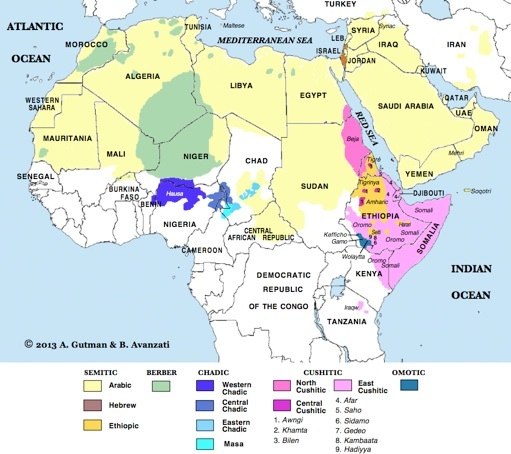An insatiable appetite for ancient and modern tongues


Afro-Asiatic Languages

Address comments and questions to: gutman37@yahoo.com
Overview. Afro-Asiatic languages (formerly called Hamito-Semitic) are spoken by more than 400 million people, living in northern Africa, the Horn of Africa, and in South-West Asia. With the exception of the extinct Sumerian, Afro-Asiatic has the longest documented history of any language phylum in the world: Egyptian was recorded as early as 3200 BCE while the documentation of Semitic languages goes back to 2500 BCE. Contradictory hypothesis claim the African or Asian origin of Afro-Asiatic.
Classification and Distribution. Afro-Asiatic is divided into six branches: Semitic, Berber, Egyptian, Cushitic, Chadic and Omotic. Semitic and Berber are quite closely related, and both are more distantly connected to Cushitic. Omotic is the most controversial member of Afro-Asiatic.
Map of Afro-Asiatic languages distribution (click to enlarge it)
a) Semitic includes Arabic, Hebrew and several Ethiopic languages, namely Amharic, Tigre and Tigrinya.
b) Berber includes several dialects or closely related languages spoken in North Africa.
c) Egyptian includes only the extinct Ancient Egyptian.
d) Chadic encompasses many languages (between 140 and 195), spoken around Lake Chad in western Africa, of which the largest is Hausa.
e) Cushitic is a highly diverse group of languages spoken in the Horn of Africa. Oromo, Somali and Beja are its major representatives.
f) Omotic includes nearly 30 languages, spoken in western Ethiopia, of which Wolaytta and Gamo are the largest.

Speakers and Major Languages. About 470 million people worldwide speak an Afro-Asiatic language of which 310 million are Arabic speakers. Semitic languages are spoken by 351 million people, Cushitic ones by 55 million, Chadic languages by 40 million, Berber by 18 million, and Omotic by 6 million. The major Afro-Asiatic languages are listed on the table (speakers in millions).
SHARED FEATURES
-
✦ Phonology
-
-The vocalic system was originally limited to the three vowels a, i, u in Semitic, Berber and Egyptian. In contrast, Chadic, Cushitic and Omotic have fuller vowel systems.
-
-Most Afro-Asiatic languages include a third series of consonants, called emphatics, alongside the voiced and voiceless series. The emphatics may be pharyngealized consonants as in Arabic and Berber or glottalized. The latter may be ejectives as in Ethiopian and Cushitic or implosives as in Chadic.
-
-A striking characteristic is the lack of the consonant p in many languages.
-
-Chadic, Cushitic and Omotic employ tones to make lexical, morphological or syntactical distinctions. As Proto-Afro-Asiatic was probably non-tonal, they must have acquired tones through contact with Nilo-Sharan or Niger-Congo languages.
-
✦ Morphology
-
-Semitic, Berber and Egyptian have bi- and tri- consonantal lexical roots to which vowels add grammatical information. For this reason, their languages do not write their vowels, a feature that makes linguistic comparisons and reconstructions difficult. Chadic, Cushitic and Omotic, on the contrary, have roots of unequal length which include a vowel.
-
-A rather rudimentary case system consisting of no more than two or three cases is prevalent. A number of languages mark the nominative case leaving the object case unmarked (absolutive). Chadic has no case marking.
-
-Afro-Asiatic languages distinguish masculine and feminine genders in nouns and pronouns (except in the 1st person). The feminine is marked in many languages with the suffix t.
-
-The formation of plurals is usually complex, involving vowel changes in the stem and/or a suffix marker accompanied, sometimes, by reduplication.
-
-Verb agreement with the subject, in person, gender and number, may be marked by prefixes and suffixes (in Semitic and Berber) or just by suffixes (Egyptian and many Cushitic languages).
-
-By means of affixes, markers and reduplication, derivative verbs may be formed in order to express intensive, causative, reflexive or reciprocal qualities.
-
✦ Syntax
-
-Word order is variable in Afro-Asiatic, being more an areal feature than a genetic one, e.g., eastern languages (Ethiopian and those of the Horn of Africa) are usually Object-Verb, while other languages (Berber, Egyptian, Chadic and non-Ethiopian Semitic) are Verb-Object.
-
© 2013 Alejandro Gutman and Beatriz Avanzati
Further Reading
-Semito-Hamitic Languages. I. M. Diakonoff. Nauka (1965).
-'Afro-Asiatic Languages'. R. Hetzron. In The World's Major Languages, 545-550. B. Comrie (ed). Routledge (2009).
-Comparative Semitic linguistics: A Manual. P. R. Bennett. Eisenbrauns (1998).
-'Afro-Asiatic'. R. J. Hayward. In African Languages: An Introduction, 74–98. B. Heine & D. Nurse (eds). Cambridge University Press (2000).
MAIN LANGUAGE FAMILIES
LANGUAGE AREAS
Languages of Ethiopia & Eritrea
LANGUAGES by COUNTRY
LANGUAGE MAPS
-
• America
-
• Asia
-
Countries & Regions
-
-
Families
-
• Europe
-
• Oceania
As the Language Gulper has no advertisements it is essential that we receive some financial help, however small, in order to keep the site running and eventually expand it.
So, please, make a donation if you can.
